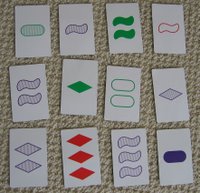The web has transformed radio. Existing stations like
KCRW in Santa Monica and
XFM in Dublin can now transmit globally. Internet-only stations like
Digitally Imported for electronica and
soma fm for some local flavor can format more tightly than would ever be commercially viable on terrestrial radio. And, software like
Shoutcast (free) and
Live365 (small fee) makes it simple to broadcast on your own. However, the most revolutionary change has been the creation of services like
Launchcast and
Pandora that build custom play lists tailored to your musical preferences.

Start-up
Pandora is the newest and slickest offering. I used it briefly this past summer when it was in beta and thought their library was too small and their recommendation system too quirky, but glowing reviews in the
blogsphere and from Warren prompted me to take a more thorough look.
Getting started with Pandora couldn’t be any easier. Just go to the
main page and enter an artist or song that exemplifies the type of music you want to hear. Pandora then creates a station that will play songs that are musically similar to the one you selected. Programming is done based on analysis of song structure, not genre or other classification system.
Let’s say you are in the mood for something mellow like
Sarah McLachlan. Tell that to Pandora and it will create a Sarah station by searching for other songs that feature “mellow rock instrumentation, folk influences, [and] major key tonality.” You can further adjust what the Sarah station broadcasts by explicitly adding artists or giving tracks you don’t like the thumbs down (literally).
Listen to my Sarah stationPandora’s Flash-based UI is as simple and intuitive as it is gorgeous. For every track played, it displays cover art and an option to explain why the song was selected. Pandora also offers links to iTunes and Amazon, and a handy bookmark-able URL with a
sample of the song.
Pandora let’s you maintain 100 stations, and it works better when you create many stations rather than try to combine diverse styles and artists in one. Their approach is unique and it has its strengths and weaknesses.
For my first station I wanted to create something cutting edge so I typed in
Caged Baby and it started playing their track “Hello There.” Because they also have “prominent use of synth,” two older Human League and Severed Heads songs were in the first four suggestions. There is no way to tell Pandora that I only want new stuff.
Conversely, I wanted to create an 80’s station that sounds like
Yaz. Pandora made all the right initial selections (Erasure, Depeche Mode, New Order, Dead or Alive) but it also offered newer bands like The Magnetic Fields. I tried to give it more hints by adding artists like Ultravox, and then I ended up in pop hell with David Hasselhoff and Rick Springfield. I couldn’t hit the “I don’t like this” link fast enough.
Listen to my 80’s synth stationIf you pick a type of music where the line separating genius from cheesy is fine, Pandora selections will seem more random. Apparently that line is quite fine for synth pop and electronica but much bolder for acoustic, folk and jazz.
My experience creating a jazz station illustrated a different characteristic of Pandora. Initially I told it I liked a vocalist (Johnny Hartman) and everything was vocal. Then I added a tenor saxophonist (Ben Webster) and I was treated to a string of instrumental tracks. I added more vocalists (Ella, Sarah, Mel) and more well-known trumpeters and saxophonists, but Pandora still does not do a good job of mixing things up. Things could be worse - as I type this I have been treated to a block of songs from Dave Brubeck, Wynton Marsalis, Cannonball Adderly, Gerry Mulligan, Kenny Burrell and Stan Getz. But, it would be nice to mix a vocal back in.
Listen to my jazz stationPandora is free and its 128Kpbs stream is high enough quality for almost all listening situations. They do not have a classical offering, and, you can only skip a certain number of songs each hour, but these are the only significant limitations on this interesting service. Listen to my stations or, better yet, create your own. It’s fun, and it will only get better as their medium-sized library expands. Keep it simple, though. For best results, start with a song and Pandora will help you discover more tracks like that song. If you are interested in hearing something different, start a new station.

Yahoo!
Launchcast has been around for six years and I have been using it for the past two, ever since Scott prompted me to try it. Unlike Pandora, Launchcast offers
hundreds of pre-programmed radio stations to choose from, and it takes a very different approach to personalization.
With Launchcast, you create one station and if your tastes cross genres you can filter your station to only play certain types of music. For example, I have rated electronic, alternative, indie and jazz artists. My station can format a mix of these or I can use “
moods” to filter based on genre to play only jazz.
Launchcast’s recommendation approach is different as well. It relies on user ratings for songs and artists and collaborative filtering to decide what to play. For example, if I tell Launchcast I like Death Cab for Cutie, American Analog Set and David Wilcox, it will see which other bands people who like these artists also enjoy. It works very well as they have more than 6 billion user ratings to draw on.
It is not hard to
get started with Launchcast but nothing is as simple as Pandora. Log in with a Yahoo! id and a wizard guides you through initial ratings. The more you rate the better its suggestions are but, fortunately, assigning a rating is very easy. You can specify preferences for how much new (unrated by you) music is played, and Launchcast lets you add “influencers” – people whose music tastes you like. Scott is one of my influencers.
If you use a Yahoo! co-branded dsl (SBC, ATT, etc), Launchcast Plus is bundled for free with your internet service. Plus is the version I have been using, and its significant advantages are no commercials and an unlimited number of songs skips (great for finding new music). If you don’t use a Yahoo-flavor dsl, you can experiment with the free version and subscribe to
Launchcast Plus for a few dollars a month if you like it. To get a sense of Launchcast,
listen to my station.
So which is best? It depends. I was very impressed with Pandora for jazz as it made some wonderful suggestions, but I’ve done better with Launchcast for new and indie music, areas where Launchcast’s library appears much larger. My advice, try them both while we wait for an ideal service that uses collaborative filtering to sort good music from bad and computer song-structure analysis to help define the mood.
 icon next to each mp3 file. Clicking it lets you play the file while you read. If you do not see any play icons, hit reload. To download a track, choose "Save Target As" from your contextual menu when selecting the song link.
icon next to each mp3 file. Clicking it lets you play the file while you read. If you do not see any play icons, hit reload. To download a track, choose "Save Target As" from your contextual menu when selecting the song link.



























































